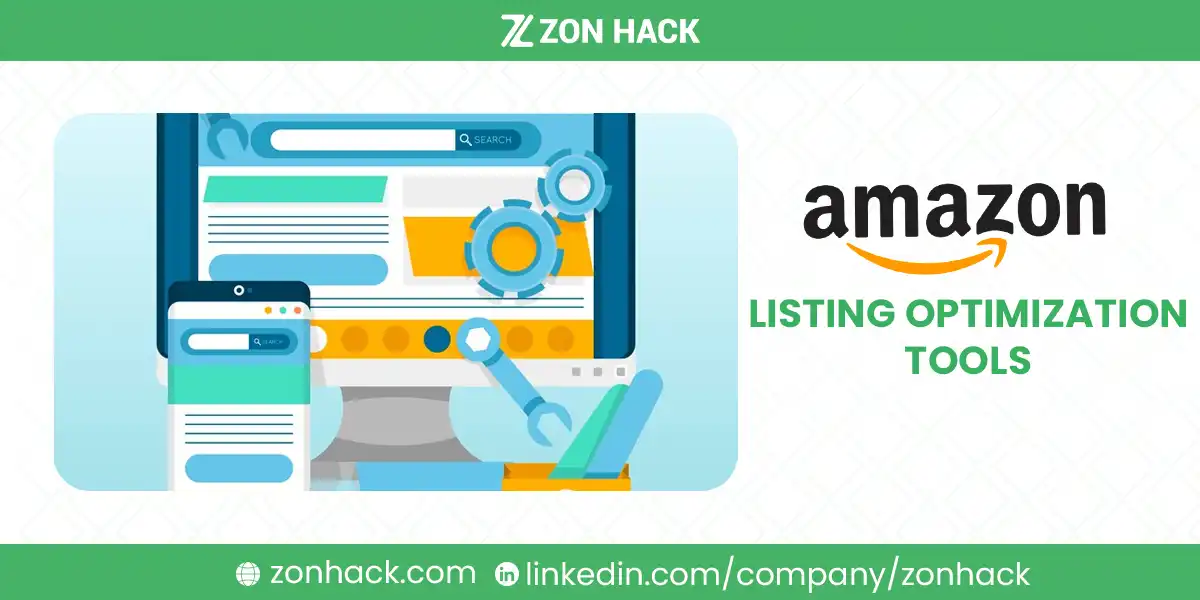Optimizing an Amazon listing can be the difference between skyrocketing sales and a product that sits stagnant in the marketplace. Amazon is fiercely competitive, with millions of sellers vying for the top spots. Effective listing optimization ensures that your product is visible, engaging, and conversion-friendly.
A well-optimized listing includes compelling titles, bullet points, descriptions, high-quality images, and backend keywords that align with what customers are searching for. However, managing and perfecting these elements manually is labor-intensive and prone to errors. That’s where these listing optimization tools come in.
Why Use Amazon Listing Optimization Tools?
Amazon listing optimization tools are designed to automate the otherwise tedious process of improving your listings. They make it easier to identify high-performing keywords, analyze competitors, and A/B test different elements of your listing. Without these tools, sellers risk spending countless hours on manual research, keyword analysis, and content improvement. Tools make it possible to make data-driven decisions quickly and accurately, which is essential in the fast-paced world of eCommerce.
By providing insights into your listing’s performance and that of your competitors, these tools help you continually refine your product’s visibility and appeal. Additionally, many tools offer features like A/B testing, which allow you to try out different versions of your titles, descriptions, or images to see what resonates best with your audience.
What Are the Best Amazon Listing Optimization Tools?
With a plethora of options available, it can be overwhelming to choose the right tool. Below is a detailed overview of 15 top Amazon listing optimization tools, each with unique features and pricing.
1. Helium 10
Helium 10 is one of the most comprehensive Amazon seller tools available, making it a favorite among both beginners and advanced sellers. It offers an array of features, including keyword research, listing optimization, competitor analysis, and inventory management. Helium 10’s most popular feature, Cerebro, allows sellers to find profitable keywords by analyzing their competitors’ listings. In addition, Frankenstein helps users refine keywords by eliminating irrelevant ones, ensuring your listings are optimized for the most relevant search terms.
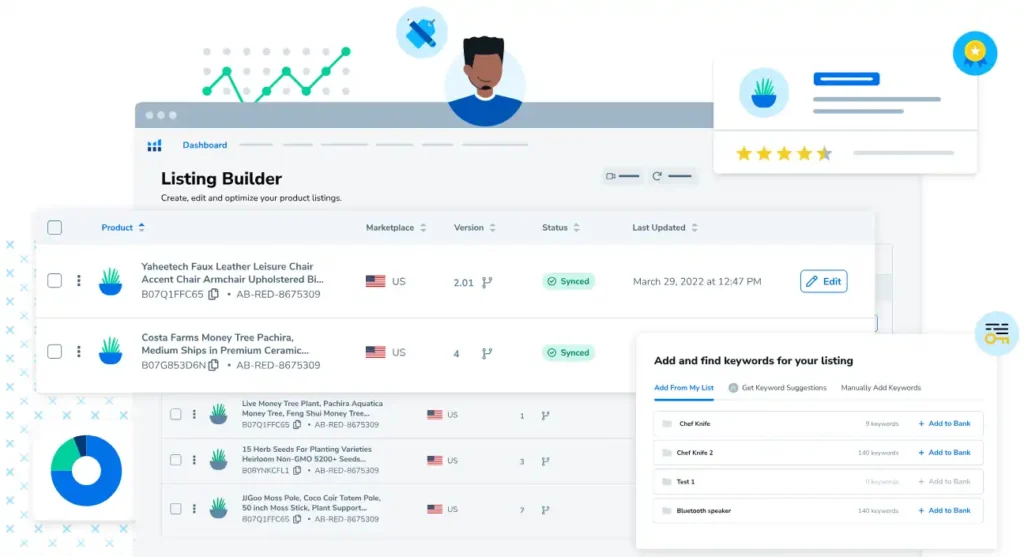
Another significant benefit is Helium 10’s listing analyzer, which checks the health of your listing based on its SEO performance, keyword use, and compliance with Amazon’s guidelines. Helium 10 also offers review monitoring, which enables you to track customer feedback in real time, making it easier to adjust your product descriptions or keywords as needed.
Pros:
- Comprehensive toolset covering all aspects of selling on Amazon.
- A wide range of tools for beginners and experienced sellers alike.
- Powerful keyword research and competitor analysis features.
Cons:
- The wide range of features can be overwhelming for new users.
- Pricing plans can be expensive, particularly for small sellers.
Pricing: Helium 10 offers a free plan with limited features, while premium plans start at $39/month.
2. Jungle Scout
Jungle Scout is known for its product research capabilities, but it also shines as an Amazon listing optimization tool. It provides robust features for keyword scouting, listing creation, and sales tracking. The keyword scout feature helps identify high-traffic keywords that will boost your product’s ranking. Jungle Scout’s listing builder allows sellers to create listings optimized for SEO and conversions by suggesting high-ranking keywords based on search volume.

For those looking to monitor their sales and competitors closely, Jungle Scout offers a suite of sales analytics tools that track your product’s performance in real-time. With these insights, you can adjust your listings to match buyer intent and trends. Jungle Scout also offers a supplier database for those looking to streamline their product sourcing.
Pros:
- Excellent keyword research and product sourcing tools.
- User-friendly interface ideal for new sellers.
- Offers real-time sales tracking.
Cons:
- Product research tools may not be as relevant for experienced sellers focused purely on listing optimization.
- Lacks some advanced SEO features that Helium 10 provides.
Pricing: Plans start at $49/month, with no free tier available.
3. AMZScout
AMZScout is particularly useful for sellers focusing on both product research and listing optimization. The keyword tracking tool lets you monitor how specific keywords are performing and how they affect your product’s ranking. AMZScout also features a listing optimization tool that audits your listings, highlighting areas that need improvement, such as missing keywords or poorly structured content.
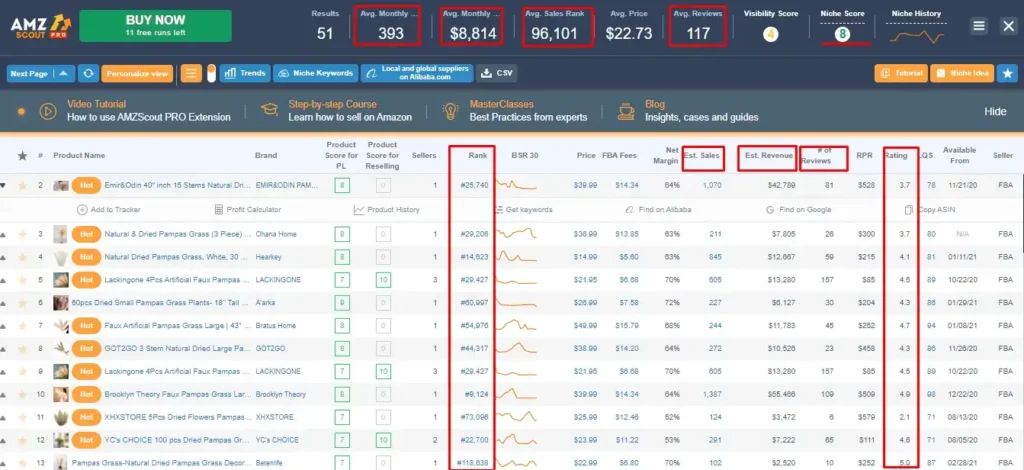
For sellers who are constantly on the go, AMZScout offers a Chrome extension that lets you conduct product research and keyword tracking directly from Amazon’s product pages. This makes it a highly convenient option for sellers looking to perform quick, on-the-fly optimizations.
Pros:
- Provides a comprehensive toolset for both product research and listing optimization.
- Offers a Chrome extension for on-the-go listing management.
- Affordable pricing for small sellers.
Cons:
- Limited customer support compared to larger tools like Helium 10.
- Some features are not as robust or in-depth as those in Jungle Scout.
Pricing: Free trial available, with paid plans starting at $29/month.
4. SellerApp
SellerApp is a data-driven platform that offers listing quality checkers, real-time keyword tracking, and competitor analysis. The platform also provides product research features that help sellers identify new product opportunities while simultaneously optimizing their current listings. One of SellerApp’s standout features is its review insights tool, which uses sentiment analysis to evaluate customer feedback and adjust listings accordingly.
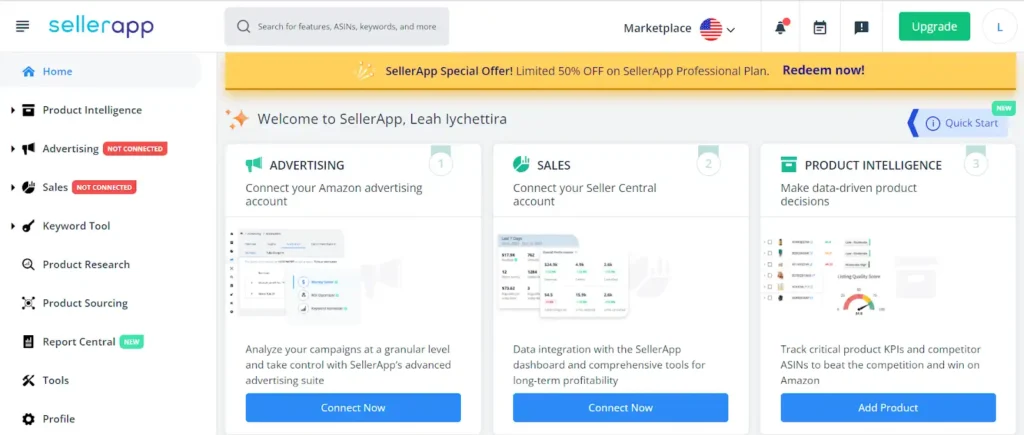
SellerApp’s listing optimizer breaks down every element of your product listing and assigns it a score based on SEO performance. This helps sellers understand exactly where they need to improve, from their product title to the backend keywords.
Pros:
- Real-time data insights for keywords and competitors.
- Sentiment analysis for reviews to identify customer pain points.
- Detailed listing quality checker.
Cons:
- The learning curve can be steep for new users.
- Pricing is on the higher side for small-scale sellers.
Pricing: Plans start at $39/month.
5. ZonGuru
ZonGuru is a well-rounded tool with features like listing optimization, A/B testing, and competitor tracking. What sets ZonGuru apart is its business dashboard, which provides sellers with detailed analytics about their performance, including sales data and keyword ranking trends. The tool’s listing optimizer helps sellers identify which keywords to use and where to place them in titles, descriptions, and bullet points.

For sellers looking to fine-tune their listings, ZonGuru also offers A/B testing tools that allow you to test different elements of your listing, such as titles or images, to see which performs better in terms of conversion rates.
Pros:
- User-friendly interface.
- Comprehensive business dashboard with real-time sales data.
- A/B testing capabilities.
Cons:
- The number of tools may be overwhelming for smaller sellers.
- Some users report occasional bugs in the keyword tracking feature.
Pricing: Plans start at $24/month.
6. Viral Launch
Viral Launch is another powerful tool, especially for sellers looking to dominate their niche. It combines listing optimization with PPC automation and product research, making it a one-stop shop for Amazon sellers. Viral Launch’s keyword research tool helps sellers uncover profitable keywords, while its listing analyzer provides insights into how well your listing is optimized.

The platform also includes a competitor intelligence feature, which allows you to monitor the strategies of top competitors and adjust your listings accordingly. For sellers who run Amazon ads, Viral Launch’s PPC automation tools can help streamline campaigns and maximize ad ROI.
Pros:
- Great for sellers focused on scaling their business.
- Offers PPC automation in addition to listing optimization.
- Provides detailed competitor analysis.
Cons:
- One of the more expensive options for listing optimization.
- Can be too complex for small or new sellers.
Pricing: Plans start at $69/month.
7. Sellics
Sellics is an all-in-one solution for listing optimization, PPC automation, and sales analytics. Sellics uses data from Amazon’s API to provide real-time insights into your product’s performance, from keyword rankings to PPC spend. The listing optimization feature helps sellers adjust their listings to maximize SEO and conversion rates, while the review management feature enables sellers to monitor customer feedback and respond quickly.

One of Sellics’ standout features is its profit dashboard, which provides detailed insights into your overall profitability, including costs related to Amazon fees, PPC, and shipping.
Pros:
- Comprehensive tool for both listing optimization and PPC.
- Detailed profit dashboard for tracking sales and expenses.
- Real-time data integration with Amazon’s API.
Cons:
- Pricing is based on sales volume, making it expensive for high-volume sellers.
- Some features, like PPC automation, may not be relevant for all sellers.
Pricing: Pricing varies based on sales volume, with plans starting at $49/month.
8. MerchantWords
MerchantWords is a powerful Amazon keyword research tool that helps sellers identify long-tail keywords and phrases that potential buyers are searching for. This tool specializes in capturing search trends across various international markets, making it an excellent choice for sellers expanding their reach. MerchantWords offers detailed keyword data that can be directly applied to product listings, helping to improve their discoverability.

Additionally, MerchantWords offers a listing advisor feature that provides insights on how to improve keyword usage and ranking performance. For international sellers, MerchantWords covers several Amazon marketplaces like the UK, Canada, Germany, and more.
Pros:
- Excellent for discovering long-tail keywords.
- Covers multiple international Amazon markets.
- Easy-to-understand keyword data.
Cons:
- Lacks advanced listing optimization features.
- The interface may feel dated compared to newer tools.
Pricing: Starts at $29/month.
9. DataHawk
DataHawk offers a well-rounded platform for Amazon listing optimization by providing tools for keyword tracking, product analysis, and advertising performance. With DataHawk’s keyword tracking tool, sellers can monitor their rankings for specific keywords and adjust their listings to ensure they remain competitive.
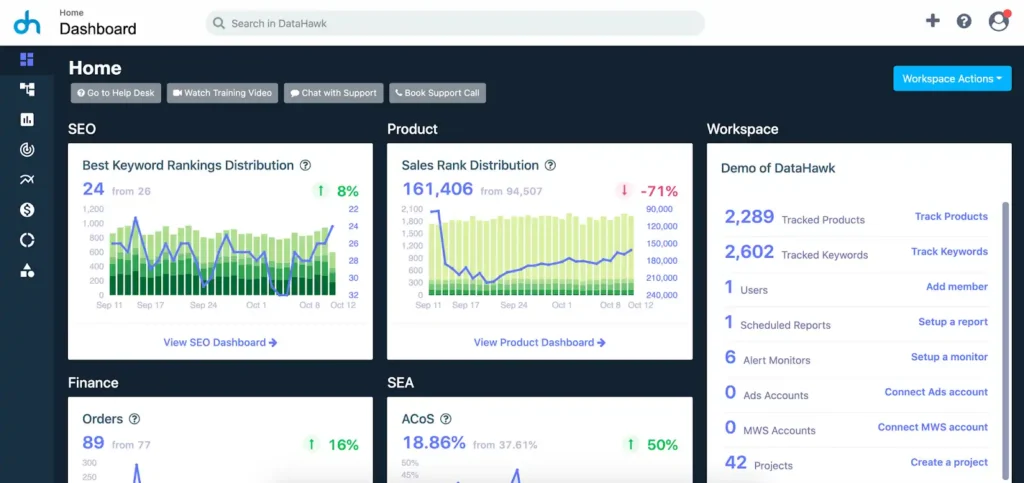
The listing optimization tool provides recommendations for improving the structure of your listings, including suggestions for better keyword placement and content formatting. DataHawk also offers sales and advertising dashboards, helping you make data-driven decisions to boost both organic and paid traffic to your listings.
Pros:
- Excellent keyword tracking and analytics.
- Provides detailed insights into advertising performance.
- Data-driven recommendations for listing improvements.
Cons:
- Not as user-friendly for beginners.
- Pricing can be high for smaller sellers.
Pricing: Free plan available, with premium plans starting at $49/month.
10. Scope by Seller Labs
Scope by Seller Labs is specifically designed for Amazon listing optimization through keyword research and competitor analysis. This tool provides keyword suggestions based on actual Amazon data, making it easier for sellers to optimize their product titles, bullet points, and descriptions.

Scope also allows you to track competitor listings, helping you stay ahead by analyzing their keyword strategies. For sellers running Amazon ads, Scope integrates with PPC campaigns to offer suggestions for improving ad copy and targeting the most relevant search terms.
Pros:
- Focuses on listing optimization through keyword research.
- Competitor analysis feature helps refine listing strategies.
- Integrates with Amazon PPC campaigns.
Cons:
- Limited to keyword research and competitor tracking.
- Fewer listing management features compared to other tools.
Pricing: Plans start at $49/month.
11. Kibly
Kibly focuses on automating the optimization of Amazon listings, helping sellers craft engaging product descriptions and titles. The tool uses machine learning to identify high-performing keywords and suggests where they should be placed within your listing for maximum effect. Kibly also analyzes your listing’s performance and provides personalized suggestions for improvements based on the latest Amazon algorithm updates.

Kibly is particularly useful for sellers who want a tool that handles the bulk of the optimization work automatically. It also provides insights into customer feedback, helping you adjust listings based on user sentiment.
Pros:
- Automated listing optimization based on machine learning.
- Provides insights into customer feedback and sentiment.
- Easy-to-use interface for beginners.
Cons:
- Lacks more advanced features like PPC automation or competitor tracking.
- Limited to listing optimization, not suitable for broader Amazon needs.
Pricing: Plans start at $67/month.
12. Sellics Benchmarker
Sellics Benchmarker is a sub-tool within the Sellics platform, designed to help sellers compare their product listings to their competitors in terms of performance. This tool breaks down the different metrics that influence your listing’s success, including keyword rankings, traffic, and conversion rates.

By using competitor benchmarks, sellers can see how their listing stacks up and get recommendations on how to improve key areas like keyword use and ad copy. Sellics Benchmarker is especially useful for tracking the effectiveness of your Amazon ads and their contribution to overall listing performance.
Pros:
- Detailed competitor benchmarking.
- Provides insights into ad performance.
- Comprehensive listing performance tracking.
Cons:
- Requires familiarity with data analytics.
- Pricing increases with higher sales volume.
Pricing: Integrated into Sellics’ main pricing plans, starting at $49/month.
13. FeedbackWhiz
FeedbackWhiz is primarily a review management tool but also plays a crucial role in listing optimization. The platform offers tools for email automation, feedback tracking, and product review monitoring. These features ensure that your product’s listing maintains a positive review score, which is vital for conversions.

While FeedbackWhiz doesn’t offer traditional listing optimization tools like keyword research, it provides value by ensuring that your listing has strong social proof, which directly influences SEO and conversions.
Pros:
- Excellent for managing reviews and customer feedback.
- Helps maintain positive social proof on listings.
- Automates review requests and follow-ups.
Cons:
- Limited to review and feedback management.
- Lacks direct listing optimization tools like keyword research or competitor analysis.
Pricing: Plans start at $19.99/month.
14. Keyword Tool Dominator
Keyword Tool Dominator is a specialized tool for finding the best long-tail keywords that buyers are using to search for products on Amazon. It’s particularly helpful for sellers who want to uncover untapped search terms that have lower competition but still attract significant traffic. The tool allows you to create optimized keyword lists that can then be implemented into your product titles, descriptions, and backend search terms.

Although Keyword Tool Dominator focuses mainly on keyword research, it integrates well with other listing optimization tools to help you build a more comprehensive strategy.
Pros:
- Excellent for finding long-tail keywords.
- Easy-to-use interface.
- Affordable pricing for small sellers.
Cons:
- Lacks advanced listing optimization features.
- Does not provide listing health analysis.
Pricing: One-time payment of $49.99 for lifetime access.
15. Pixelfy
Pixelfy focuses on improving the discoverability of your Amazon listings by creating custom URLs that track the performance of external traffic. These URLs help sellers monitor where their traffic is coming from, whether it’s social media, ads, or email campaigns. In addition to tracking external traffic, Pixelfy also provides keyword ranking insights, helping you optimize listings for Amazon’s search engine.

The tool works well for sellers who run external advertising campaigns and want to ensure their listings are optimized to convert this traffic into sales.
Pros:
- Excellent for tracking external traffic and keyword rankings.
- Helps boost discoverability through custom URLs.
- Provides insights into external marketing campaigns.
Cons:
- Lacks traditional listing optimization tools like competitor analysis.
- Limited to tracking external traffic.
Pricing: Plans start at $29.99/month.
FAQs
Which Amazon listing optimization tool is best for beginners?
For beginners, Helium 10 or Jungle Scout are excellent choices due to their user-friendly interfaces and comprehensive toolsets.
Can these tools help with Amazon PPC as well?
Yes, tools like Sellics and Viral Launch offer PPC automation features that integrate with listing optimization.
Are there any free Amazon listing optimization tools?
Some tools, like DataHawk and Helium 10, offer free plans with limited features. However, most robust tools require a subscription.
Do I need multiple tools to optimize my listing?
It depends on your needs. Some all-in-one tools like Helium 10 cover everything, while others like FeedbackWhiz focus on specific aspects like review management. You might need a combination of tools for the best results.
Final Words
When it comes to optimizing your Amazon listings, the right tool can make all the difference in boosting your visibility, improving your SEO performance, and increasing sales. Whether you’re a beginner looking for an all-in-one solution like Helium 10, or a seasoned seller in need of specialized tools like FeedbackWhiz for review management, these tools provide the essential insights and automation needed to stay competitive in the crowded Amazon marketplace.
By using one or more of these 15 tools, you can save time, improve your product listings, and ultimately drive more sales. Make sure to consider your specific needs, budget, and the features each tool offers to choose the best option for your business.

